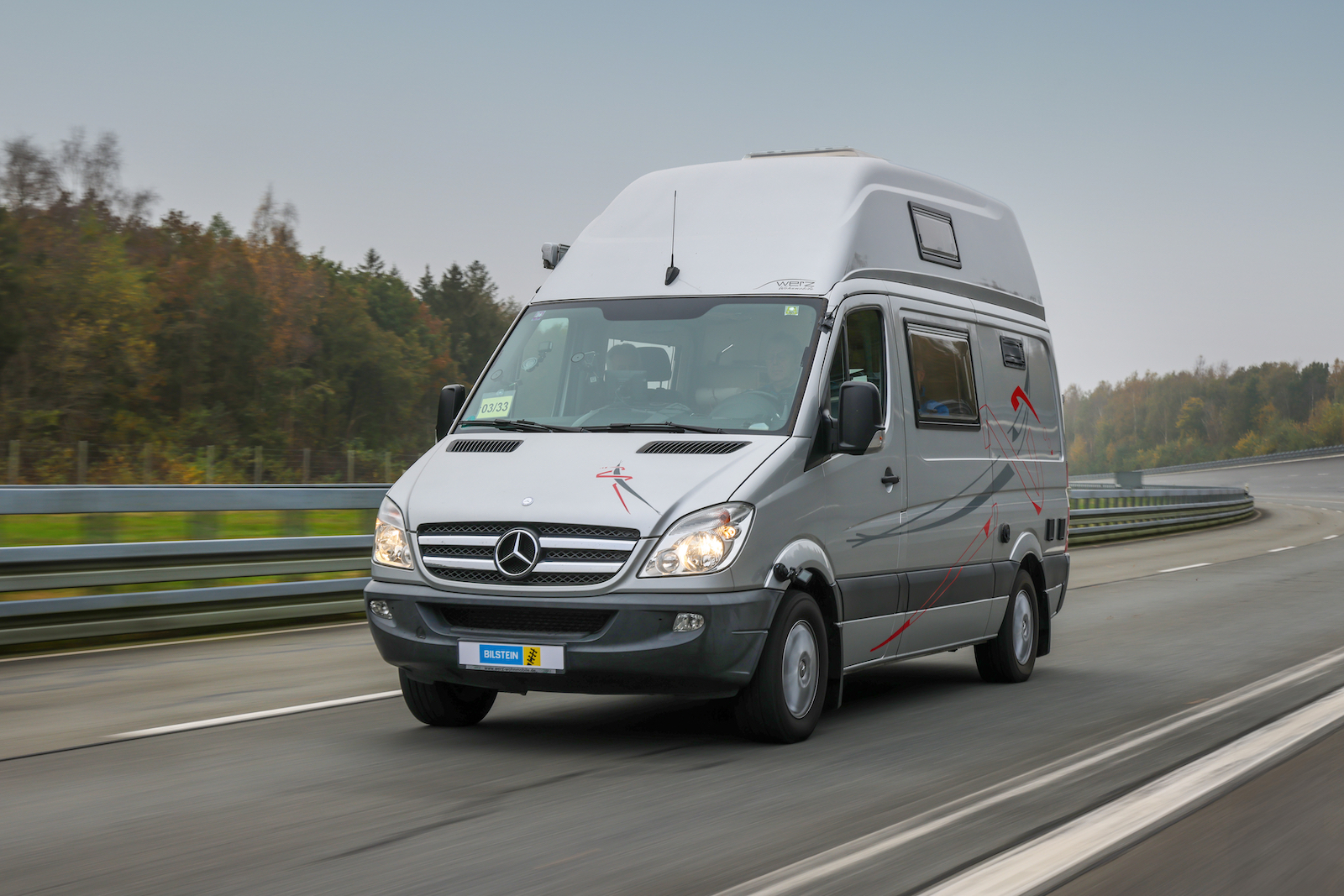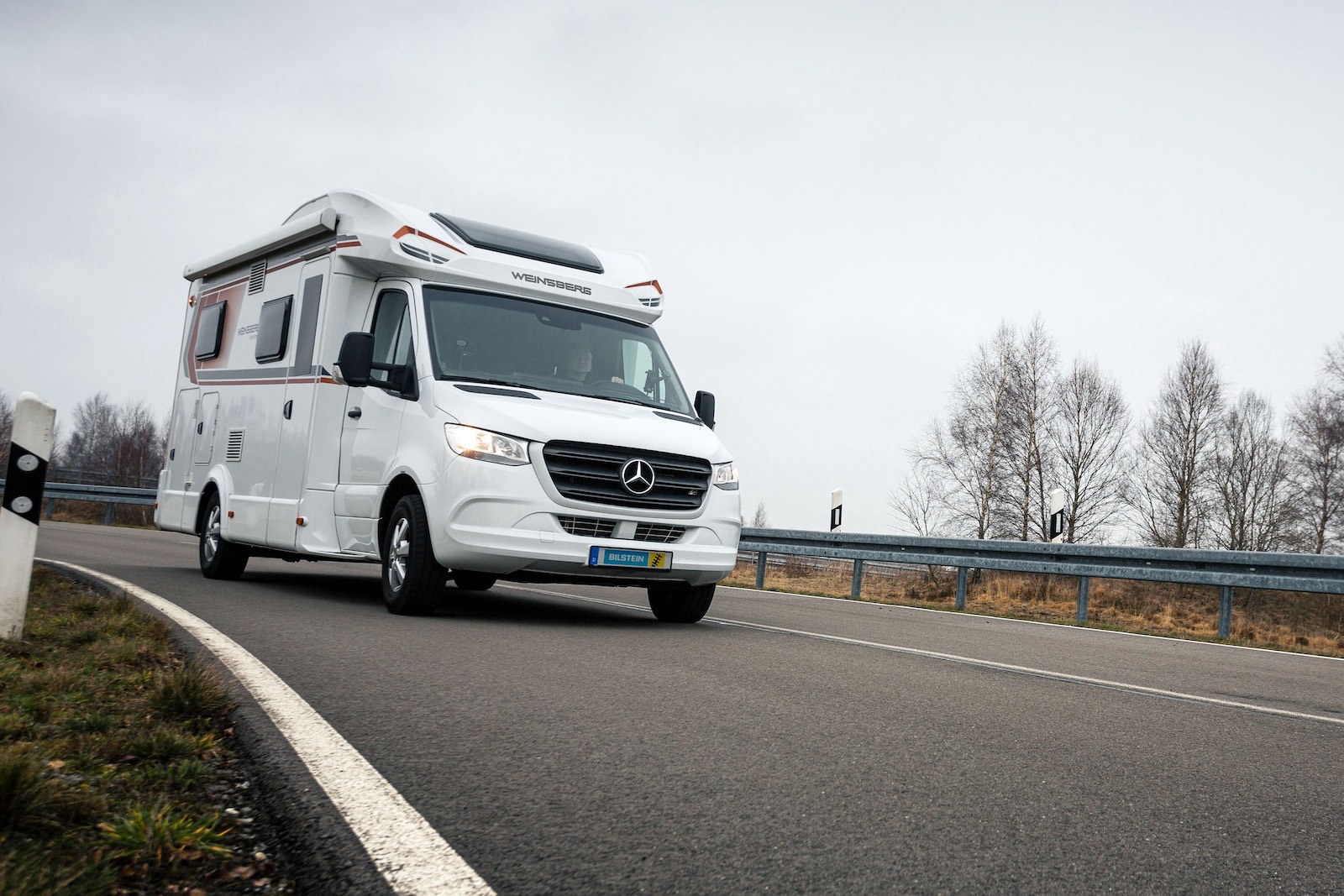- The basics: how to optimise your motor home or camper van
-
Optimising motor homes and camper vans: the subject of safety
- More comfort in a motor home? It’s the suspension that matters!
- Special camper shock absorbers for more safety and comfort: BILSTEIN B6 Camper and BILSTEIN B6 Camper Advanced
- Modern safety systems and driving assistance – what retrofit solutions are available
- Sat-nav apps for campers and motor homes
- Burglary protection and anti-theft devices for motor homes and camper vans
- Fire and gas safety
- Fire extinguisher in a motor home
-
How to optimise your motor home or camper van
- Entertainment technology and multimedia
- 5G router – your own WiFi on your route!
- LED illumination and ambience
- Toilets – what makes the difference
- Optimising the sleeping areas in camping vehicles
- Air-conditioning and ventilation systems
- Supplementary equipment for outdoor activities
- Always enough power in the motor home
- Solutions for meals on your trip
- Awning – more than just sun protection
- Camper vans: DIY conversion and customisation
- Buying a used camper van?
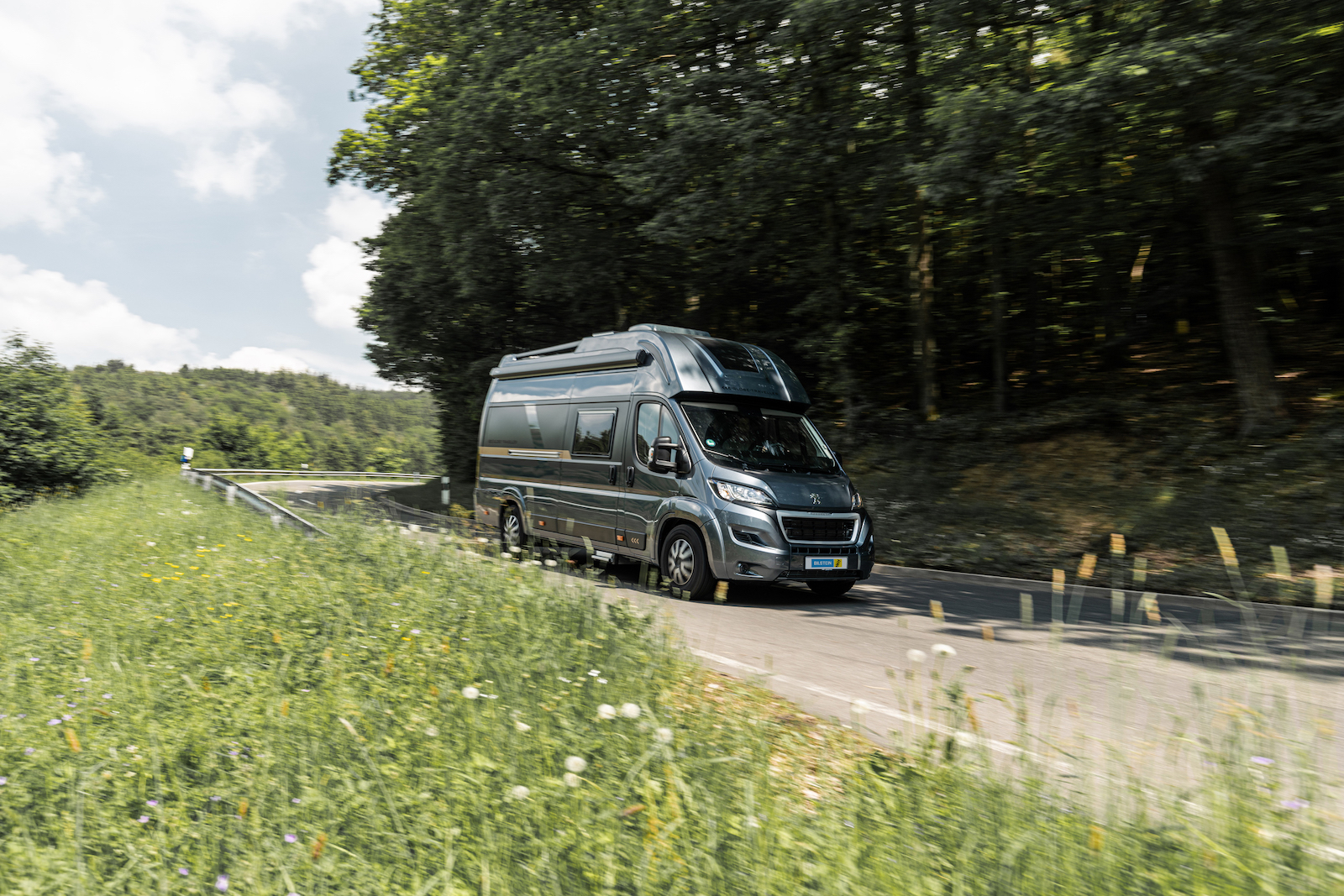

Ideas for camper conversions: optimisation of motor homes and camper vans – safety, comfort, suspension
Motor homes and camper vans have become increasingly popular over the past years. Not least due to increasing interest in flexible modes of travel and the desire to experience nature and freedom in a more intensive way. The camper vans are available in different sizes and equipment variants. From compact camper vans which are ideal for solo travellers or couples, to luxurious motor homes that offer enough space for the whole family. From DIY conversion to safety and comfort to the right suspension: we have good ideas to convert your camper and show you how to optimise your motor home or camper.
The basics: how to optimise your motor home or camper van
Fact finding: when do upgrades make sense?
Before plunging into the world of motor home optimisation, it is essential to know about your vehicle and your wishes. This analysis is the key to deciding when and which upgrades make sense. First of all, you should assess the current condition of your vehicle in terms of function, safety and comfort. Questions such as “does the equipment still meet current travel needs?” or “are all safety-relevant components up to date?” will help you to prioritise.
Upgrades are of course particularly useful if they increase safety, improve travelling comfort or increase the Vehicle’s efficiency. For example, older motor homes could benefit from modern navigation systems or improved suspension, brake assist or advanced driver assistance systems. In terms of comfort, modernising sleeping areas, upgrading kitchen equipment or installing more efficient heating and cooling systems can make a significant difference.
Energy efficiency is also an important aspect. Installing solar panels or converting to LED illumination are not only environmentally friendly, but can also save costs in the long run.
However, it is important to compare the budget with the actual benefits of each upgrade. Not every modern feature is necessary for a motor home owner or enhances the vehicle’s value. A thorough assessment and a clear idea of your needs are therefore essential in order to make reasonable and satisfying improvements to your motor home. After all, you will be taking your home with you when you travel, so make it as pleasant and cosy as possible and increase comfort as well as practical value.
What are the differences between turnkey camper vans and DIY conversions
Camping, van life, ready-made camper vans or DIY conversions. There is no right or wrong! When deciding between a ready-made motor home and DIY conversion, numerous factors play a role that range from individual needs and skills to budget and time frame. Turnkey motor homes such as the Mercedes Sprinter and camper vans offer the advantage of being ready for immediate use. They are professionally designed and usually include a full range of optimised equipment based on years of experience in the motor home industry. These vehicles often offer a higher standard of comfort and safety, but are generally more expensive and offer less scope for customisation.
In contrast, DIY extensions allow for a customised design that is precisely tailored to personal needs and preferences. Such projects open up a lot of options for your creativity, from room layout to selecting specific materials and functionalities. They are usually less expensive, but require a high degree of planning, technical skills and time. DIY conversion can be a rewarding experience. However, it also involves risks with respect to quality and safety if you do not have the necessary knowledge and the right tools. In addition, you also need to keep an eye on the regulations when converting a camper van yourself, otherwise its registration can quickly fail.
In summary, turnkey camper vans and motor homes offer comfort and quality straight from the factory, while DIY conversions are a personalised and possibly cheaper option, but require a significant investment of time and work. The choice depends on individual preferences, available budget and personal skills.
Ideas to extend a camper – the subject of safety
More comfort in a motor home? It’s the suspension that matters!
Motor homes and camper vans are generally based on a commercial vehicle. When developing such vehicles, their specifications often do not aim at maximum passenger comfort. Especially the suspension quickly reaches its limits. Due to the greater mass and higher centre of gravity of a motor home compared to a normal car, the demands on the suspension are significantly higher. A high-quality suspension ensures better road handling, which is particularly important on longer journeys and in different road conditions. It helps to minimise the effects of bumps and vibrations, which significantly increases driving comfort.
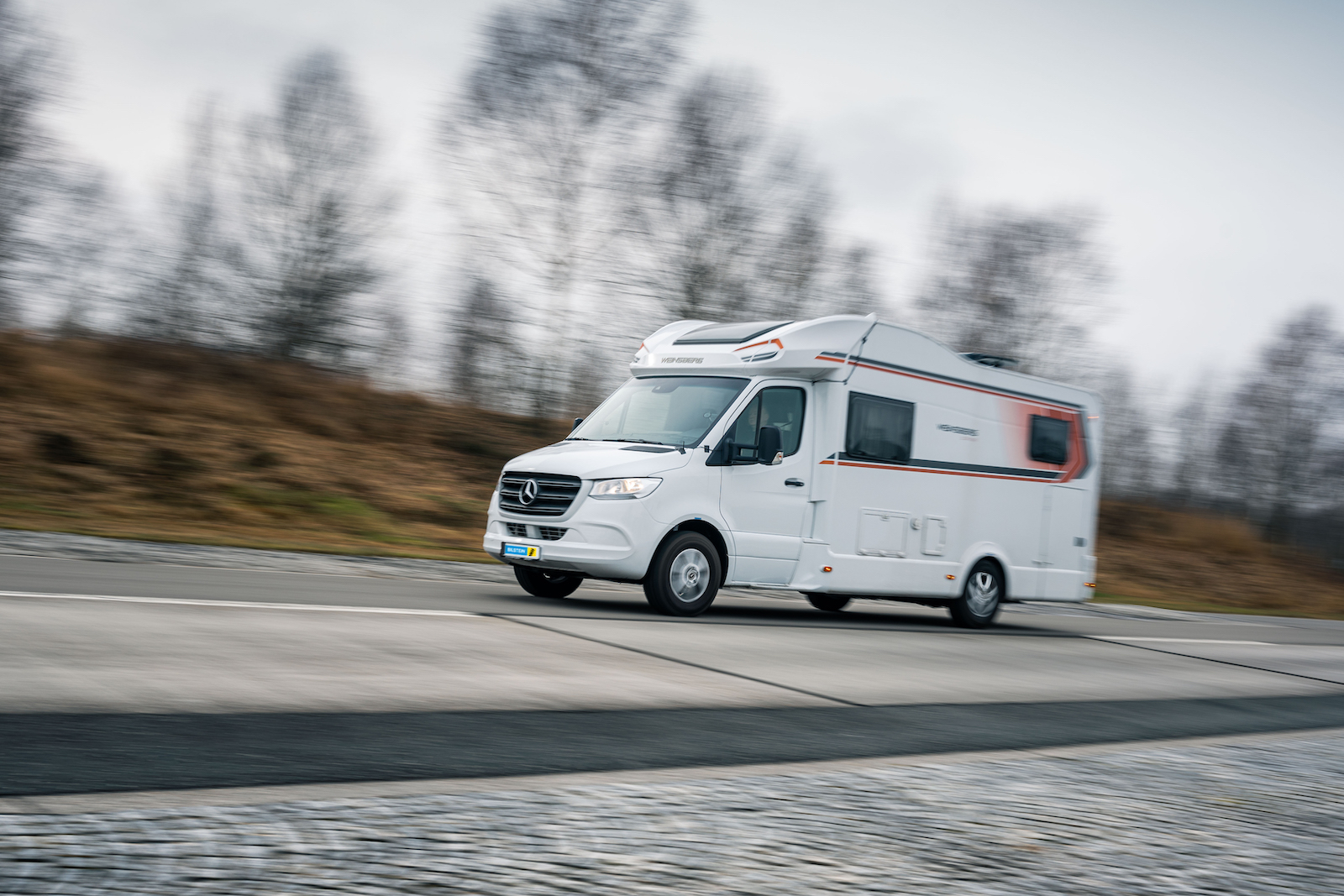
Another important aspect is safety. A robust suspension improves the handling of the vehicle, which is particularly important in critical situations such as strong gusts or emergency manoeuvres. Motor homes are also often exposed to higher loads, as they not only carry passengers, but often also additional weight in the form of luggage, equipment and sometimes even a trailer. A powerful suspension is therefore essential to carry these loads safely and ensure consistently good performance.
Special camper shock absorbers for more safety and comfort: BILSTEIN B6 Camper and BILSTEIN B6 Camper Advanced
In this context, the special BILSTEIN shock absorbers for motor homes and camper vans are recommended. BILSTEIN B6 Camper shock absorbers offer significantly improved stability and damping compared to standard suspension systems, which makes a particular difference in heavier motor homes. The BILSTEIN B6 Camper Advanced shock absorbers even go one step further. They not only offer all the advantages of the B6 Camper, but also a driving experience that is otherwise only known from premium cars. The Advanced shock absorber utilises the patented BILSTEIN DampMatic system, which we developed in collaboration with Mercedes-Benz. The centrepiece of this technology is the automatic damping force adjustment, which works purely mechanically and therefore does not require expensive electronics. It enables two different characteristic curves: the shock absorber usually damps very comfortably, while at the same time providing high damping forces when the situation demands it. In this way, it maintains stability during slow excitations from the road. It automatically evens out very fast excitations, for example bumps.
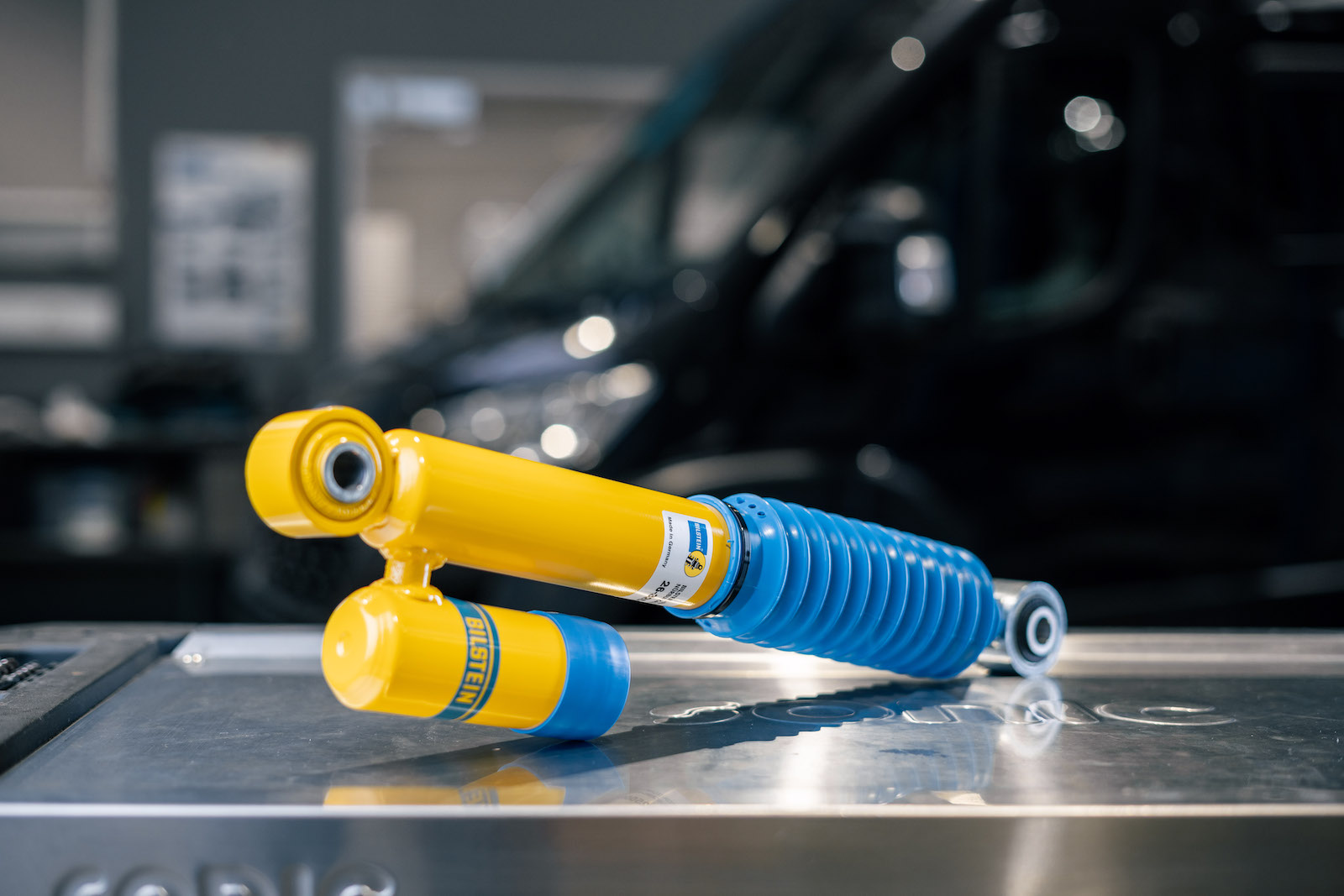
The BILSTEIN B6 Camper Advanced are ideal for all who regularly travel long distances and expect maximum performance and safety in a variety of conditions.
Investing in high-quality suspensions and shock absorbers such as BILSTEIN B6 Camper or BILSTEIN B6 Camper Advanced is therefore not only a question of comfort, but also an important decision in terms of safety. It is a long-term investment that significantly improves the driving quality and the overall experience with the motor home.
Find a workshop in your vicinity now and have your motor home or semi-integrated vehicle converted to the new shock absorbers from BILSTEIN.
FIND A WORKSHOP NOWModern safety systems and driving assistance – what retrofit solutions are available
The range of available retrofit solutions is extensive and enables older vehicles to be upgraded to a newer safety level. The most popular retrofits include rear view cameras and parking aids, which make manoeuvring with large vehicles considerably easier. They offer improved visibility and help to avoid collisions, especially in narrow camping sites or in the city.
There are also retrofit solutions for improved lighting, such as LED headlights and fog lights, which improve visibility in poor weather conditions. Approved retrofit solutions are now also available. Tyre pressure monitoring systems, which inform the driver of any loss of pressure, also make a significant contribution to safety.
Sat-nav apps for campers and motor homes
There are a number of reasons why it is appropriate and important to use dedicated sat-nav apps for campers and motor homes. Especially when there are restrictions for the vehicle, such as height limits. Standard navigation solutions are often not tailored to the specific needs and dimensions of motor homes. This can end up in problems, such as driving on roads with height restrictions, which are not a problem for normal cars but can turn out to be a dead end for a taller motor home.
Sat-nav apps dedicated to campers and motor homes take such restrictions into account. They offer customised routeing that takes into account the specific dimensions and weight of the vehicle. This includes height and weight restrictions, bridge loads or the width of roads. Another advantage of these apps is that they take into account pitches, camping sites and service facilities that are relevant for camping fans. For example, petrol stations with suitable pumps for larger vehicles or disposal stations.
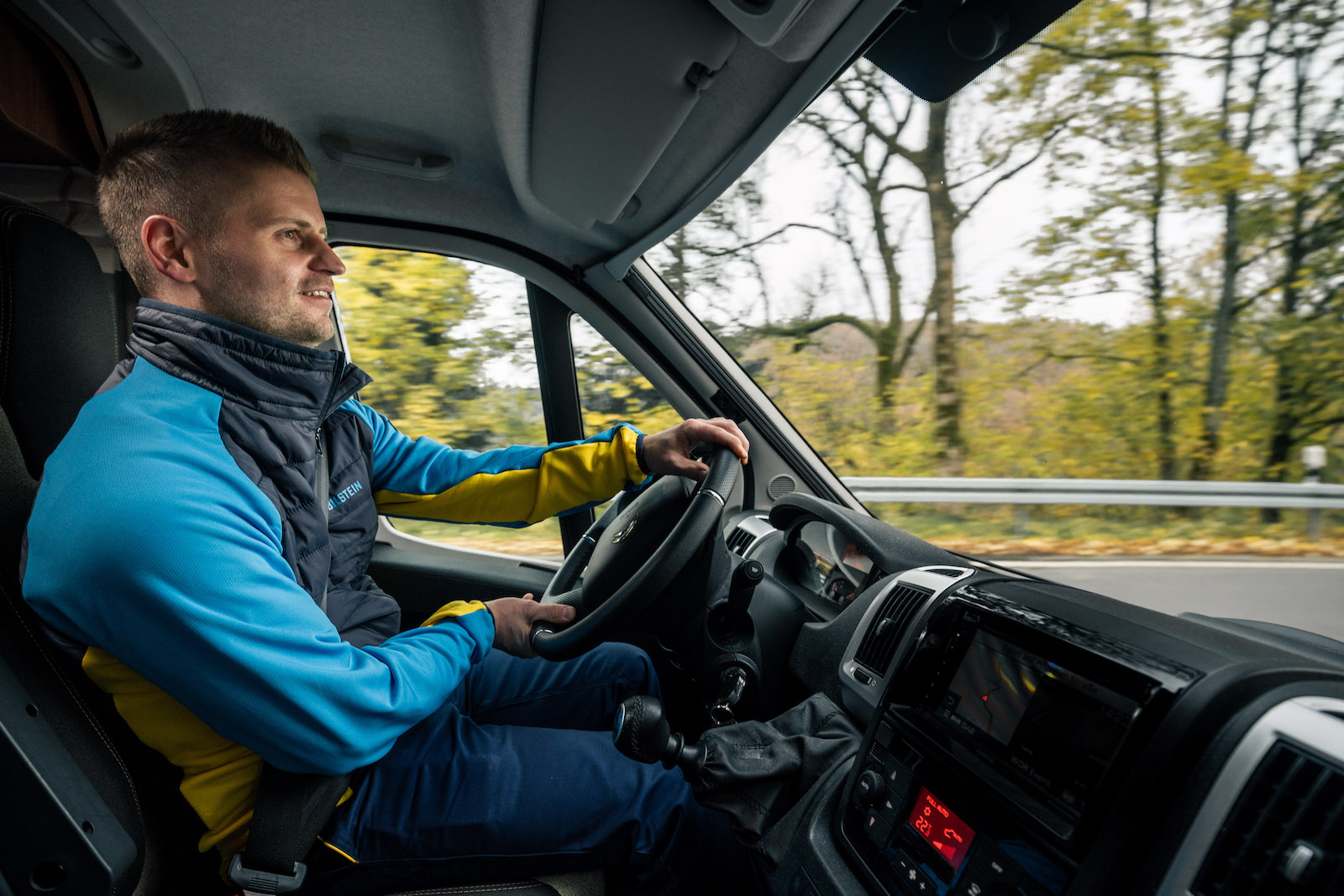
In addition, these apps often offer real-time traffic information and alternative route suggestions, which is particularly useful on long journeys or in unfamiliar areas. Using such a dedicated sat-nav app not only increases safety and comfort when travelling, but also helps to avoid unexpected delays and difficulties.
Burglary protection and anti-theft devices for motor homes and camper vans
Effective burglary protection starts with basic measures such as securely locking all doors. An additional method of increasing security is to safeguard the doors with straps, which makes it more difficult to force them open. Window locks also play an important role. Additional locks or latches can be fitted to make it more difficult to pry the windows open.
In addition to the physical protection of the vehicle, anti-theft protection is another important aspect. Installing a GPS tracking system is an effective measure. Such systems make it possible to locate the vehicle in the event of theft and send the position to the relevant authorities. GPS trackers can be installed in a hidden location so that they are not visible to potential thieves. They provide an additional layer of security by increasing the likelihood of the vehicle being recovered in the event of theft.
Immobilisers and steering wheel locks are essential security measures in the fight against vehicle theft. An immobiliser provides electronic protection by preventing the engine from starting. Unless the thief uses a specially coded key or remote control. These systems are often factory-installed or can be added as a retrofit solution. They serve as potent deterrent as they make it much more difficult to steal the vehicle.
The steering wheel lock is another effective measure and a highly visible deterrent. It attaches directly to the steering wheel and prevents it from moving. Its high visibility immediately signals that the vehicle is additionally secured, which alone can deter many thieves from trying to steal the vehicle.
Fire and gas safety
Smoke detectors are an essential safety feature. They provide early warning in the event of smoke or fire inside the vehicle. Their installation in sleeping and living areas of the motor home can be crucial in alerting occupants in good time and giving them the opportunity to react appropriately before a fire spreads.
In addition to smoke detectors, gas sensors play an equally important role. They are indispensable, as motor homes and camper vans are often fitted with gas-powered appliances such as cookers, heaters and fridges. Gas sensors can detect leaking propane, butane or carbon monoxide and trigger an alarm. It happens long before the gas concentration reaches dangerous levels. This is particularly important as gases such as carbon monoxide are colourless and odourless and therefore may not be noticed without such sensors.
Regular maintenance and testing of these safety systems is essential to ensure their functionality. This includes regularly testing the sensors and smoke detectors and replacing the batteries. In addition, motor home owners should be familiar with basic safety measures in the event of a gas leak or fire, including the use of a fire extinguisher.
Fire extinguisher in a motor home
By the way, in addition to safety in your own vehicle, carrying a fire extinguisher is also a matter of responsibility towards others. In the event of a nearby fire, quick intervention with a fire extinguisher can be decisive in limiting damage or even saving lives. It is therefore advisable, regardless of the legal obligation, to always carry a fire extinguisher in the motor home and to regularly check that it is in working order.
Camper extensions: how to optimise your motor home or camper van
Entertainment technology and multimedia
How about more ideas for camper conversion? Here you go! Entertainment technology and multimedia play a decisive role in the area of comfort enhancements. This equipment contributes significantly to the enjoyment of the journey and can transform the vehicle into a mobile entertainment centre. Popular upgrades include high-definition TV sets equipped with satellite antennas to receive a wide range of channels. This allows travellers to enjoy their favourite shows or movies on their way. What’s more, the integration of streaming services is becoming increasingly important.
By using Wi-Fi connections or mobile data, travellers can access a wide range of media libraries and streaming platforms, providing entertainment to suit individual tastes. Modern sound systems, which are often equipped with Bluetooth functionality, also make it possible to play music or podcasts in high quality and thus create a pleasant atmosphere in the vehicle.
Game consoles or integrated multimedia systems with games functions are a popular addition for families or travellers with children. They offer entertainment and fun during long journeys or relaxing days at the campsite. The integration of tablets or smartphones into the motor home’s entertainment system, for example through mirroring functions, also considerably expands the entertainment options.
5G router – your own WiFi on your route!
The integration of a 5G router in a camper revolutionises mobile internet and enables travellers to always have a reliable and fast internet connection while on the road. When establishing your own WiFi in a motor home it is important to opt for a 5G router that offers both a high transmission speed and a good range. Make sure that the router is suitable for use in the vehicle, which includes in particular a robust design and reliable performance under various environmental conditions. Choosing a suitable data tariff that meets the needs and data volume of the travellers is of equal importance.
The antenna configuration of the router is also worth considering. An external antenna can significantly improve signal strength and stability, especially in remote areas or where the 5G network is not yet fully developed.
LED illumination and ambience
When it comes to ideas for camper van conversion, the aspects of light and ambience should not be forgotten. Using LED lighting in motor homes and camper vans can play a crucial role in creating a pleasant and inviting ambience. LEDs offer a variety of lighting options that go far beyond mere functionality. By using dimmable LEDs, camping fans can adjust the light intensity as required, creating a cosy and relaxing environment, especially in the evening. LEDs are more energy efficient than conventional light bulbs, which is particularly advantageous in a motor home where energy consumption plays an important role. Their durability reduces the need for frequent replacements and their robustness makes them ideal for the moving environment of a motor home.
Toilets – what makes the difference
Choosing the right toilet for a camping vehicle is an important aspect that significantly influences comfort and convenience when travelling. There are different types of toilets, each with their own advantages and special features.
Cartridge toilets are mostly used in motor homes. They consist of a fixed bowl and a portable cassette. The cassette is simply removed from the vehicle for emptying. These toilets are easy to operate and maintain, but require regular emptying and cleaning.
Vacuum and incinerating toilets are more expensive and complex to install. Vacuum toilets are similar to those in aeroplanes and use very little water. Incinerating toilets, on the other hand, burn the waste and do not require emptying, only the ash needs to be removed occasionally. Composting toilets need to be emptied regularly. They use biological processes to convert solid waste into compost. They are waterless and environmentally friendly, but require careful maintenance and regular emptying of the compost.
Choosing the right toilet for a motor home depends on various factors, such as the size of the vehicle, travelling habits, the budget, and personal preferences.
Optimising the sleeping areas in camping vehicles
High-quality ergonomically designed mattresses that have been specially developed for the dimensions and conditions in motor homes, camper vans and similar vehicles can significantly increase sleeping comfort. They should offer good support and their firmness should be adapted to individual preferences. Another aspect is the use of customised bed frames, which enable efficient use of space and at the same time provide a stable base for the mattress.
Breathable bed linen and climate-regulating covers also help to improve the sleeping climate. They ensure a comfortable temperature and moisture control. Additional sleeping accessories such as special pillows and blankets can also help to enhance sleeping comfort.
Light and noise insulation are also important to create a peaceful and relaxing sleeping environment. The use of curtains or blinds can help to minimise disturbing light from outside. The installation of sound-absorbing materials or additional seals on windows and doors can also help to reduce external noise.
Air-conditioning and ventilation systems
Auxiliary heating systems are indispensable, especially in colder months or when travelling to cold regions. They make it possible to heat the motor home efficiently and evenly independent of the engine. This saves fuel and helps protect the environment. Modern auxiliary heating systems can be operated with diesel, gas or electricity and often offer the option of programmable control so that the vehicle is already preheated when entering.
In contrast, air conditioning setups provide pleasant coolness inside the vehicle during the warmer months. They are essential for creating a comfortable interior climate even when outside temperatures are high. Like auxiliary heating systems, they can be operated independent of the vehicle’s engine, making them ideal for longer stays or at night.
When selecting heating and air conditioning systems, it is important to ensure that they are appropriately dimensioned for the size and insulation of the motor home. A system that is too strong or too weak can be inefficient and impair comfort. In addition, energy-efficient models should be preferred to minimise energy consumption and operating costs.
Good ventilation is also important to ensure fresh air in the interior and prevent condensation. Roof lights and windows with integrated ventilation systems can help to ensure a constant exchange of air. However, you should also think about anti-theft protection for the vents and windows, as retrofit solutions in particular should be well secured.
Supplementary equipment for outdoor activities
Proper supplementary equipment is essential for lovers of outdoor activities. Having the right mounts to safely and efficiently carry equipment such as bikes, kayaks, surfboards or hiking gear is a key component. High-quality mounts not only ensure secure fastening during travel, but also easy handling when loading and unloading equipment.
Bicycle racks are among the most popular accessories. They can be mounted at the rear or on the roof of the motor home and should be selected to suit the weight and type of the bicycles. Water sports equipment such as kayaks or surfboards require special roof racks or rear rack systems that allow for secure and aerodynamic attachment.
When buying mounts, it is important to look for a robust design and materials that can withstand the stresses of wind and weather. Furthermore, they should be fastened in such a way that they do not obstruct access to doors, storage compartments and other important parts of the motor home. Some systems also offer additional security features such as locks to protect the equipment from theft. Always pay attention to the vehicle’s maximum payload when choosing supplementary equipment.
Always enough power in the motor home
Most campsites and pitches for camper vans and motor homes have external power connections. But sometimes you need to be completely self-sufficient when travelling. For example, when the campsite is fully booked. Reliable power supply is crucial to ensure an independent and comfortable travelling experience. The combination of batteries, power banks and solar energy is an effective solution to always have enough power available.
Modern motor homes often have powerful batteries that provide the energy for lighting, heating, kitchen appliances and other electrical systems in the vehicle. It is important to choose a battery that offers sufficient capacity for the traveller’s needs. Lithium-ion batteries are a popular choice as they offer higher energy density, longer life and faster charging times compared to traditional lead-acid batteries. Portable power banks provide additional mobility and convenience. They are ideal for charging smaller devices such as smartphones, tablets or cameras on the go. Some models even offer the option of operating laptops or small household appliances without an inverter (already integrated). Solar energy is an environmentally friendly and efficient way to cover the electric demand in the motor home. Solar panels on the roof of the vehicle can be used to charge the batteries during the day. This reduces dependence on external power sources and enables more sustainable travelling. Modern solar systems are available in various sizes and performance classes, so they can be adapted to meet the energy requirements and available space on the roof of the motor home.
Ideas for camper extension: solutions for meals on your trip
Some motor homes and camper vans offer the option of integrating or retrofitting a fully equipped outdoor kitchen. These kitchens can be equipped with a gas hob, sink, worktops and even small fridges. They are ideal to prepare complete meals and offer all the convenience of an open-air kitchen. Portable barbecue grills are an excellent option for barbecue lovers. They are available in various designs, from compact charcoal barbecues to gas barbecues with multiple burners. Some models are specially designed for use in motor homes and can be easily stowed and transported. Modern multifunctional cooking appliances, such as electric multi cookers or portable induction hobs, offer another flexible solution for preparing food. They are space-saving, versatile and ideal for quick, uncomplicated dishes. The Thermomix, for example, is not only used in the “Sansibar” on the island of Sylt, but now also in many motor homes. However, make sure that the electrical circuit is properly protected.
Awning – more than just sun protection
Awnings are an indispensable accessory for motor homes, featuring far more than just sun protection. They offer a flexible, extended outdoor living space and significantly contribute to increased comfort. Modern awnings also protect from light rain, allowing to sit outside even when the weather is contrary. Modern awnings are user-friendly and can be easily extended and retracted. Some models even offer motorised systems that can be operated at the touch of a button or by remote control.

Ideas to extend a camper – DIY conversion and customisation
Planning and realisation of DIY conversion
Planning and realisation of a camper van conversion is an exciting project that allows for a high degree of customisation and creativity. The process of converting your camper van begins with careful planning that takes into account your own needs and the intended use of the vehicle. At first, the interior layout should be designed, paying attention to efficient use of space, ergonomic design and the integration of necessary functions such as the sleeping area, kitchen and bathroom.
When selecting materials, keep an eye on quality and durability. The weight is also important, as this affects driving dynamics and fuel consumption. Insulation and ventilation are other important aspects to ensure a pleasant climate in the vehicle. Electric installations, such as lighting and sockets, should be carefully planned and safely implemented. Care should also be taken when installing gas and water systems and it is recommended to call in specialists for this purpose.
A key aspect of DIY conversion is flexibility. Requirements may change or new ideas may come up during realisation. It is important to be open to adjustments in your planning without losing sight of the overall concept and budget.
DIY conversion requires manual skills and a certain technical understanding. Many enthusiasts use online resources, forums and social media groups to find tips and instructions. There are numerous YouTube videos of DIY conversions for motor homes and a community of insiders who are also meeting. It’s easy to find inspiration at such a meeting: from a converted coach with a whirlpool to an electric van with a recording studio, the possibilities are almost endless.
Legal aspects and technical inspection certificate
When converting a camper van on your own, there are various legal aspects to consider and the need for a technical inspection certificate to ensure that the vehicle complies with legal requirements and can be operated safely on the road. Firstly, the converted vehicle must fulfil the legal requirements for registration as a motor home, which usually includes existence of certain facilities such as a sleeping area, cooking facilities and storage space.
Once the conversion has been completed, a technical inspection certificate is required. This includes a detailed inspection of the technical modifications, gas and electrical installations and general vehicle safety. In individual expert opinion may be required in individual cases. The effects of the conversion on insurance and road tax should also be clarified in advance, as the change in vehicle type can have an impact.
Furthermore, it is crucial that all conversions comply with safety standards, which includes the proper installation of gas and electrical systems, the securing of furniture and fittings and compliance with weight and stability specifications. Careful documentation of the conversion process and all installed systems and components is also recommended, as it facilitates the technical inspection and serves as proof of proper execution.
Buying a used camper van?
What should be considered?
When buying a used motor home, it is important to consider several key factors to ensure that you are purchasing a reliable and well-maintained vehicle. Carefully inspect the vehicle’s general condition first. Pay attention to external damage, rust or signs of accident repairs. Also have a close look into the interior, check all fittings for wear and tear, cleanliness and functionality.
Check the technical aspects of the motor home, especially the engine, gearbox and other important mechanical parts. A test drive is indispensable to ensure that the vehicle drives well and does not make any unusual noises. Pay attention to the brakes, steering and overall performance of the vehicle. How about the suspension? The shock absorbers in a motor home must be in perfect condition, as must the tyres. Another important point is to check the motor home’s service history. A well-maintained vehicle should have a clear history with regular maintenance work and repairs. Ask for documentation such as inspection reports, maintenance invoices and other relevant documents.
Also check the function of all equipment, such as heating, air conditioning, kitchen appliances and sanitary facilities. Don’t forget to look for moisture damage or mould, especially in hidden areas such as under beds, in cupboards and around windows.
What inspections are required for a motor home?
In Germany, regular inspections are required by law for motor homes to ensure that the vehicle is roadworthy. The general inspection, often carried out by “TÜV”, is a comprehensive check of the vehicle. It needs to be performed every two years. During the general inspection, the vehicle is checked for roadworthiness, including brakes, steering, lighting, exhaust system and other safety-relevant components. The exhaust emission test is part of the main inspection and shall ensure compliance with emissions standards. Among other things, the emissions of pollutants such as carbon monoxide and nitrogen oxides are measured during the exhaust emission test. For motor homes with a gas system, a regular gas test, known as the G607 test, is required by German law. This inspection, which generally has to be carried out every two years, is carried out by authorised inspectors and aims to ensure operational safety and protect against gas accidents. Compliance with these test intervals is particularly important, as a valid gas test is often a prerequisite for the use of camping sites and is also required to maintain the vehicle’s operating licence.
The G607 test is an inspection of the entire gas pipe system of the motor home. This includes checking the gas lines, connections, valves and gas appliances such as the heater, refrigerator and hobs for leaks and proper functioning. Safety equipment such as pressure regulators and gas cylinder boxes are also checked. The inspector ensures that the installation complies with the applicable safety standards and that there are no leaks or damage that could lead to dangerous situations.
Find a workshop in your vicinity now and have your motor home or semi-integrated vehicle converted to the new shock absorbers from BILSTEIN.
FIND A WORKSHOP NOW
